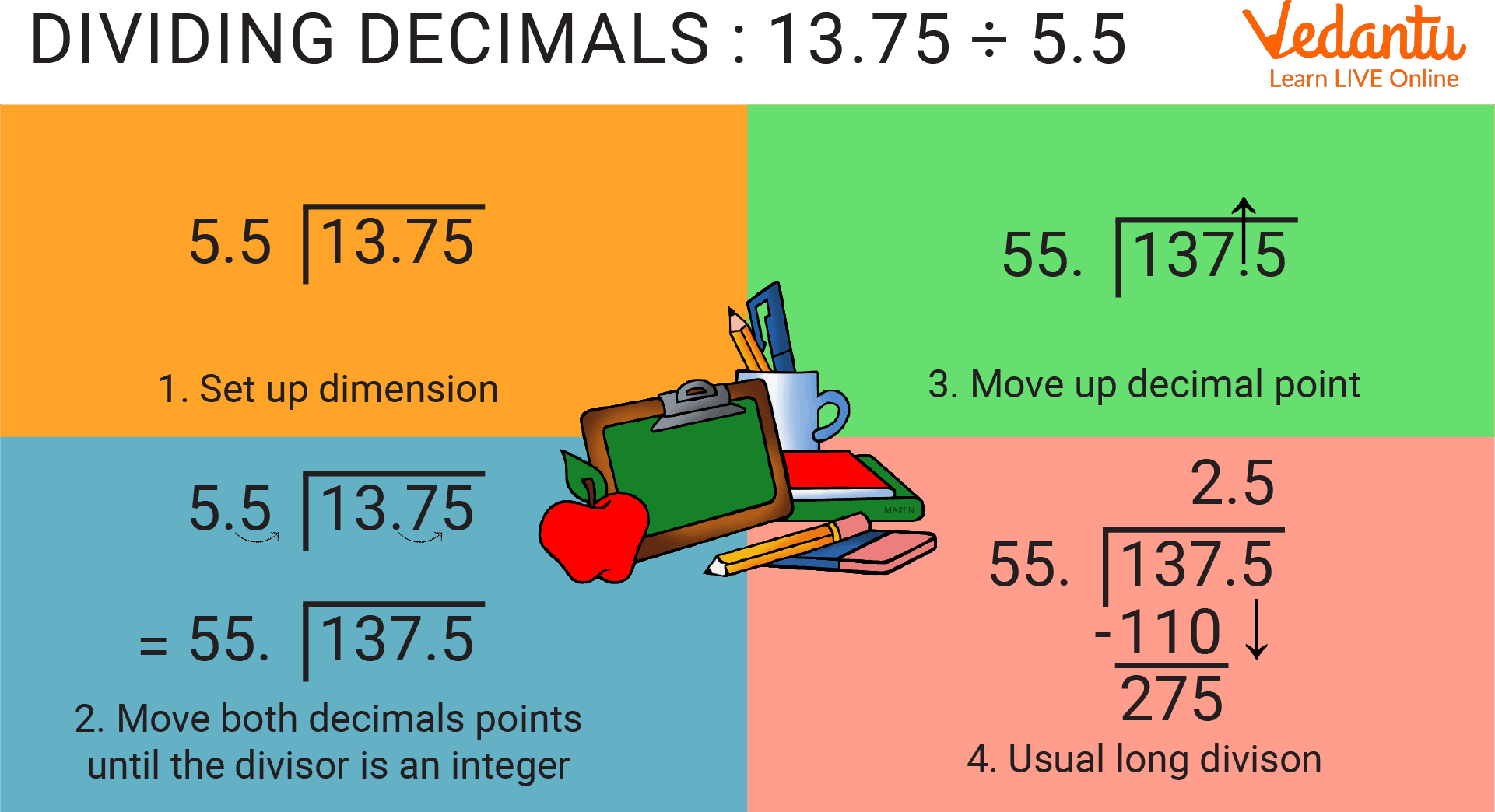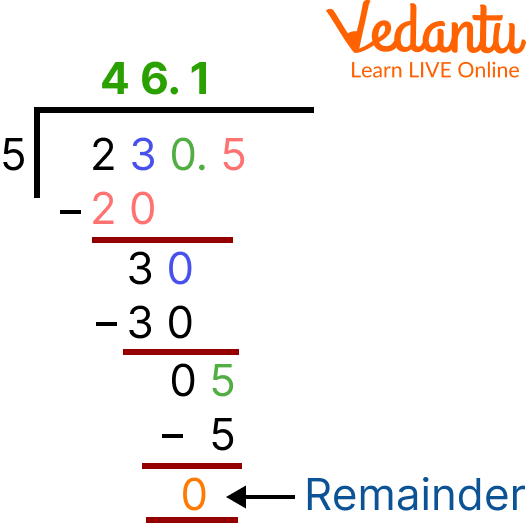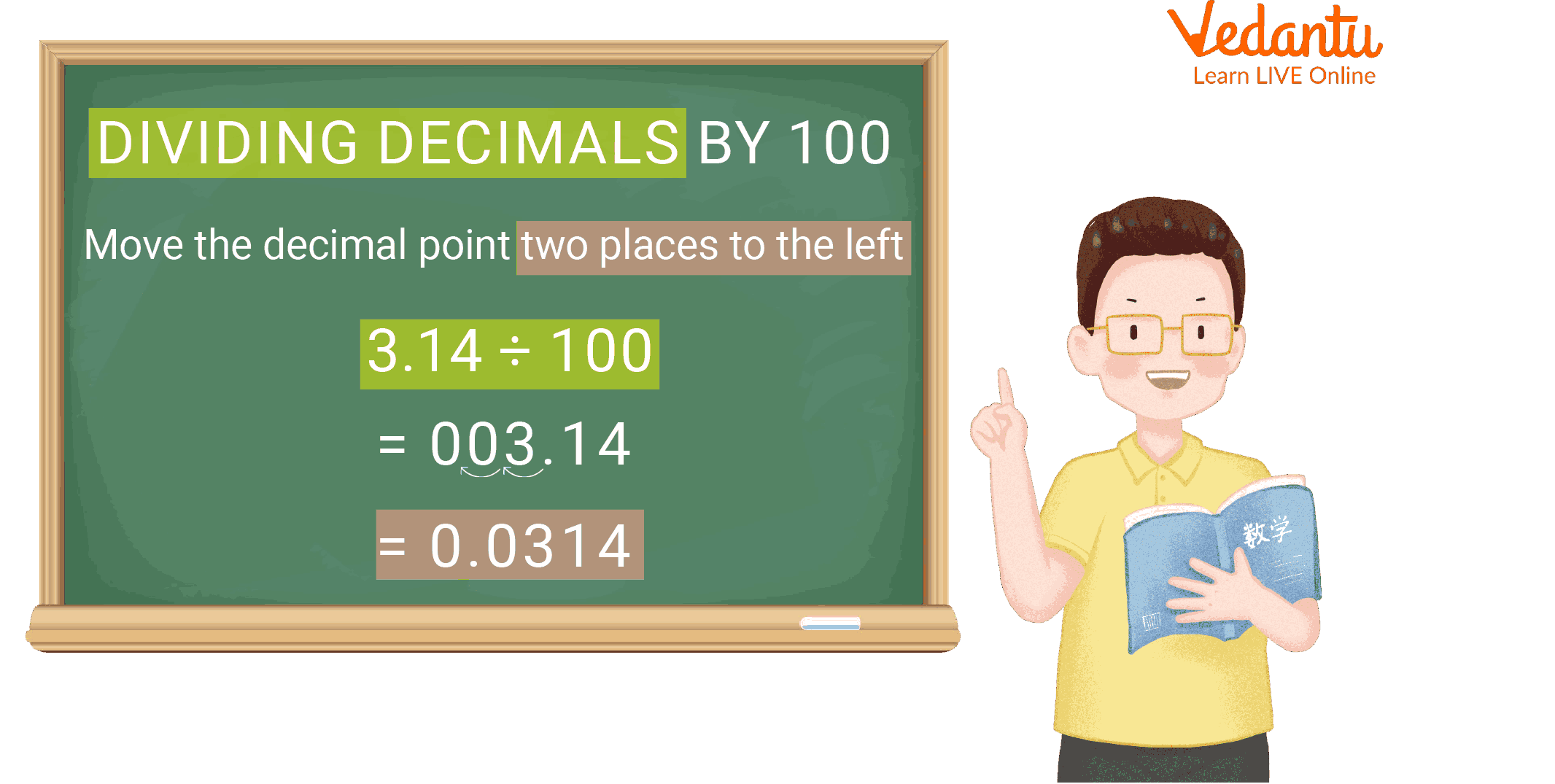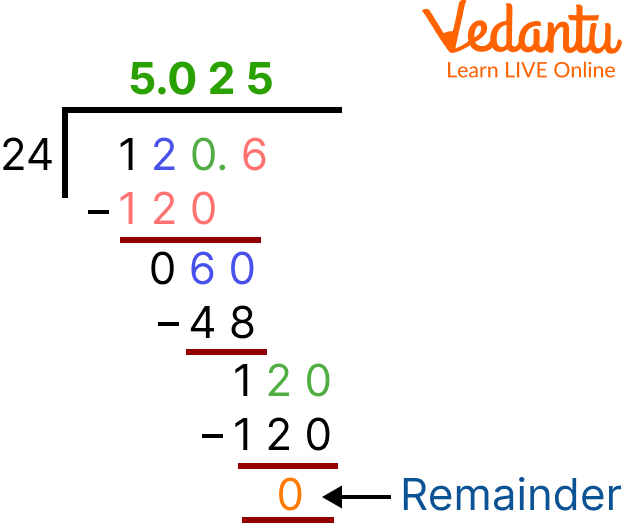




Introduction to Decimal Division
Decimal division is similar to dividing whole numbers, but a decimal point is inserted after each decimal place. Mathematicians divide decimals similarly to how they divide whole numbers. We must first understand what decimals are and what decimal points mean before we can understand the decimal division method.
A decimal is a numeric type that has two parts separated by a decimal point: a whole and a fraction. It is called a decimal point because it resides between parts of whole numbers and fractions. Furthermore, these numbers can be added to, subtracted from, multiplied, and divided with various arithmetic operations.
How are Decimals Divided?

Dividing Decimals
As we divide whole numbers, we also divide decimals, except the way the decimal point is handled is different. Decimals can be divided in the following ways:
Calculating decimal division by whole numbers.
Divulgation of a decimal by another decimal.
Ten, one hundred, and a thousand decimal divisions.
How Do Decimals Work?
A fractional point (also called a 'decimal separator') separates the whole part from the fractional part of a number with a point or a dot. However, in the UK, children are taught to write a point as the decimal separator, as opposed to a comma. To help children understand decimal numbers, the connection between decimal numbers and fractions will be discussed in the next section.
How to Do Decimal Division?
The whole number and fractional part of a decimal number are separated by a dot. Decimal points are the dots in decimal numbers. A value less than one appears after the decimal point. This is termed as the basic decimal division rules.
A decimal number of 17.48 features 17 as the whole number and 48 as its decimal part.
In this way here, we can use decimal division rules to find the division.
Dividing Decimals by Whole Numbers
Mathematicians divide decimals according to certain rules. The examples below show how dividing decimals by whole numbers can be done.
24 Divided by 120.6
In this case, 120.6 ÷ 24 = 5.025
Division by Five: 230.5 Divided by 5

5 Divided by 230.5
The answer is 46.1 since 230.5 x 5.
The formula for dividing a decimal number by another decimal number is: When we divide numbers, we've to convert the divisor to a whole number by removing the decimal point to the right. Again, we remove the decimal point up the even number of points to the right. This can be deduced with the help of the following sample.
Example: Divide 4.88 by 0.4
Example: 15 divided by 0.2
When we multiply 0.2 by 10, we get a whole number
0.2 × 10 = 2,
But we must go to the 15
15 × 10 = 150
Thus, 15 ÷ 0.2 can be written as 150 ÷ 2
150 ÷ 2 = 75
And so the answer is
15 ÷ 0.2 = 75
Dividing Numbers by 10, 100, and 1000

Dividing Decimal by 100
Dividing numbers by 10, 100, and 1000 leaves us to find the division of a decimal Consider the number 97.5 10 = 9.75. Thus, the digits in 97.5 and 9.75 are the same, i.e., 9, 7, and 5, but the decimal point in the quotient has shifted (to the left). As a result, when dividing a decimal by 10, the decimal point will shift to the left by one position because 10 has only one zero above 1.
We may conclude from the preceding example that when dividing decimals by 10, 100, or 1000, the number and quotient digits will be the same. However, the decimal point in the quotient shifts to the left by the number of zeros greater than one.
Practice Problems
Q1. $69.27 \div 0.3 ?$
Ans: 230.9
Q2. $1.329 \div 0.06 ?$
Ans: 22.15
Summary
Thus, in this article we learnt about the decimal division. The decimal division is similar to dividing whole numbers, except for how we handle the decimal point. In addition, we learned the lengthy system of dividing decimal numbers. With the help of some examples, we learnt the division of decimals by whole numbers. We have also learned the long division styles to divide.
FAQs on Decimal Division
1. What is the most important rule for dividing decimals?
The fundamental rule of decimal division is to convert the divisor (the number you are dividing by) into a whole number. This is done by moving its decimal point to the right. To keep the problem equivalent, you must move the decimal point in the dividend (the number being divided) the exact same number of places to the right. After this adjustment, you perform the division as you would with whole numbers, ensuring the decimal point in the quotient is placed correctly.
2. How do you divide a decimal by a whole number? Provide an example.
When dividing a decimal by a whole number, you can perform the division directly without adjusting the decimal points initially. Simply place the decimal point in the quotient directly above the decimal point in the dividend and then divide as usual. For example, to solve 0.8 ÷ 4:
- Place the decimal point in the answer area directly above the one in 0.8.
- Divide 8 by 4, which is 2.
- The result is 0.2.
3. What is the method for dividing a decimal by another decimal?
To divide a decimal by another decimal, follow these steps:
- Step 1: Move the decimal point in the divisor all the way to the right to make it a whole number. Count how many places you moved it.
- Step 2: Move the decimal point in the dividend to the right by the same number of places. You may need to add zeros if necessary.
- Step 3: Place the decimal point for your answer (the quotient) directly above the new position of the decimal point in the dividend.
- Step 4: Divide the numbers as you normally would. For example, 7.5 ÷ 1.5 becomes 75 ÷ 15, which equals 5.
4. Why does making the divisor a whole number work in decimal division?
This method works because it is based on the principle of equivalent fractions. A division problem like 0.6 ÷ 0.2 can be written as the fraction 0.6/0.2. When you move the decimal one place to the right in both the numerator (dividend) and the denominator (divisor), you are essentially multiplying both by 10. This gives you 6/2. Since you multiplied both parts by the same number, the ratio between them remains unchanged. Therefore, the answer to 6 ÷ 2 (which is 3) is identical to the answer to 0.6 ÷ 0.2.
5. In what real-life situations is decimal division actually used?
Decimal division is crucial in many everyday scenarios where precision is needed. Common examples include:
- Splitting Costs: Dividing a restaurant bill of ₹1250.50 among 5 friends (1250.50 ÷ 5).
- Unit Pricing: Finding the price per kilogram of groceries. If a 2.5 kg bag of sugar costs ₹112.50, you would calculate 112.50 ÷ 2.5 to find the cost per kg.
- Calculating Fuel Efficiency: Determining your car's mileage. If you travel 450.75 km on 30.5 litres of petrol, you divide 450.75 by 30.5 to get kilometres per litre.
6. What is the most common mistake students make when placing the decimal point in the quotient?
The most common mistake is misplacing the decimal point in the quotient. After shifting the decimal in the divisor and dividend, students often forget to place the decimal point in the answer directly above its new position in the dividend. They might align it with the original decimal point or place it incorrectly after the division is complete, leading to a significantly wrong answer (e.g., getting 2.5 instead of 25).
7. How does dividing by a decimal like 0.5 or 0.1 affect the result?
A common misconception is that division always makes numbers smaller. However, dividing by a decimal between 0 and 1 makes the number larger. For instance:
- Dividing by 0.5 is the same as multiplying by 2. So, 10 ÷ 0.5 = 20.
- Dividing by 0.1 is the same as multiplying by 10. So, 10 ÷ 0.1 = 100.
This happens because you are finding out how many 'halves' or 'tenths' fit into the number, which is more than the number itself.











